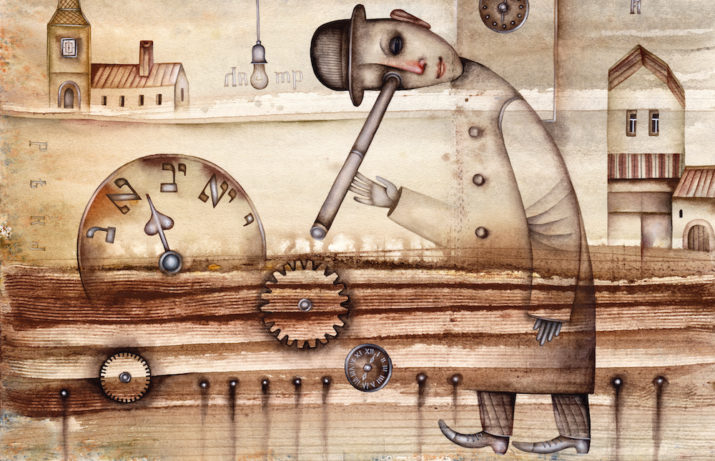

This is part of our special feature, Imagining, Thinking, and Teaching Europe.
As powerful pillars of Europe’s identity, modernity and progress have operated as central ideas for pan-European identification. Citizenship, equality, and human rights are claimed to have their “natural” home in Europe. Their histories are Europe’s history. In its post-structuralist understanding, history is theorized as a site for the negotiation of power (Rao, 2018). The past hereby operates as a normalizing framework that projects the future (Haraway, 1988). Through the lens of performativity theory, histories can thus be understood as normative scripts that are naturalized through historiography, beliefs, political speech acts, or every day encounters that pay reference to those pasts. Some histories are more hegemonic than others in the sense that they are recognized as the truth.
The history of Europe is widely regarded as a success story that projects a certain future. Discourses of progress and political modernity have placed Europe in time and space, in the center of a world imagined as peripheral (Chakrabarty, 2000). Modernity is tied to the idea of a linear development from an archaic past to a modernized future, usually recounted through European scientific inventions and their economic, social, and political applications (Bhambra, 2007). However, what is excluded from this hegemonic tale of Europe, is the centrality of colonialism, racial rule, and violent gender and sexual norms for European nation state-building and the naturalization of Europe as the superior metropolitan center of the world (Bhambra, 2007; Chakrabarty, 2000; Goldberg, 2002; Yuval-Davis, 1997).
If Europe is an imaginary figure that has been produced through said histories, then the power to define what has been left behind is a key logic in the conceptualization of Europe. I suggest that the politics behind the claim that the violence of race, sexism, and homophobia have successfully been overcome in Europe, rely on post-imaginaries. They govern gendered, sexualized, and racialized inequalities. Post-imaginaries envision social structures, time, and space. They affirm historically salient spatio-temporal binaries such as progress and stagnation or center and periphery. I will explore how post-imaginaries, like post-feminism, post-racialism and post-homophobia, operate as liberal resistance strategies against transformative social change. By normalizing hegemonic accounts of Europe’s past and present, post-imaginaries displace genealogies of inequalities and conditions of oppression. The question of how Europe is discursively placed in time and space is thus a crucial site of inquiry for a Critical European Studies project.
Post-imaginaries
Post-racialism and post-feminism have mainly been analyzed in separation from each other, although they share common logics as this article will argue. While post-racialism and post-feminism exist both as normative and (critical) analytical terms, post-homophobia has mainly been used in critical analyses of contemporary lesbian-gay politics. Post-discourses have emerged on both sides of the Atlantic in the 1990s (Gill, 2016; Kennedy, 2017; McRobbie, 2009). Race Sociologist Ian Law argues that “(p)ost-thinking implies an aftermath, a coming after or a supplanting of previous relations and ideologies” (Law, 2010 p.219). Although the prefix “post” is slippery in its use—as it signals both, breaking with the past or an unfinished process—post-imaginaries are informed by the idea of a linear time progression that is marked by “overcoming” the discursive or social conditions of what was before.
The term “post-racial” became a part of the public and political grammar after the election of US president Barack Obama. US media outlets pondered if the election of a black president represented the end of racial America (Cho, 2009). The liberal contention that the representation of non-white subjects in powerful positions did, in fact, mean an end to racial inequalities was also at the heart of British post-racial claims (Lentin & Titley, 2011). In 2010, just as the British Coalition Government was announcing a dramatic austerity program, the British magazine Prospect declared that Britain was post-racial too. This assertion was based on the claim that the British economy does not discriminate against people from black and ethnic minorities as their representation in positions of power illustrates (Mirza, 2010). The argument has since been recycled by various writers, mainly as a means to contest “identity politics” (liberal speech for anti-racism). Academic critics of said discourses have argued that post-racial projections deny the genealogies of race and racialized inequalities in order to resist anti-racist claims (Joseph-Salisbury, 2019; Lentin, 2011; Moreno Figueroa & Saldívar Tanaka, 2016). Post-racial logics should, therefore, not be mistaken as diagnostic but as political strategies.
As an analytical category, post-feminism has been used to examine the cooptation and rejection of feminism in contemporary public discourses (Gill, 2016; McRobbie, 2009). In feminist theory, post-feminism has been explored as a regime that resists and de-radicalizes feminism while affirms gender norms through liberal discourses (ibid.). In Europe, feminist explorations of post-feminism have not looked into the racialized dimension of post-feminist gender discourses even though the post-racial figure of the oppressed “migrant woman” has been operating as the subject still in need of feminism (Boulila, 2019).
Post-homophobic discourses affirm out and proud homosexual figures and liberal political gains that do not challenge heteronormativity. Analytically, the term “post-homophobic” has been used in queer theory to interrogate lesbian and gay recognition claims and policy discourses, especially after legal recognition (Boulila, 2019; Monk, 2009; Rasmussen, 2013). Post-homophobic imaginaries rely on an epistemic separation of “homophobia” from heteronormativity, gender, and race (Boulila, 2019). They refuse structural analyses of anti-gay discourses and violence and place these in the inter-personal realm whereby the state is hailed as the provider of rights and protection (ibid).
In Europe, post-imaginaries share histories, logics and effects. Post-imaginaries are not descriptive; rather, they produce a past that has been surmounted. They envision time and space and thus act as performative scripts that affirm Europe as an epistemic entity in its spatial and temporal location by drawing on the familiar logics of European modernity and imperialism. Post-imaginaries cite the well-acquainted universalizing visions of linear progress whereby Europe is positioned at the forefront of a teleological (world) history. Their spatial effects allow for a mapping of the world. They create epistemic borders such as the “post-feminist West” or “post-racial Europe.”’
Post-imaginaries are shaped by a web of discourses that are relational, adaptive, and attuned to local specificities. They appear timely and unmarked by mobilizing familiar and “common sense” logic. Rather than examining post-feminist, post-racial, and post-homophobic imaginaries as separate from each other, the following sections explore their shared power. In my examination, I will focus on how post-imaginaries successfully operate as relatable resistance strategies against feminist, queer, and anti-racist claims.
Resisting transformative social change
Post-imaginaries operate through the contention that liberal political gains make radical transformative social change redundant. Discourses that accompany these triumphant accounts of liberalism include the celebration of moderate political gains as the endpoint of liberation. These tropes also link to the later discussed displacement of histories of oppression in favor of a universal notion of difference, which results in the idea that inequalities have ceased to exist. Post-racialism, post-feminism, and post- homophobia resist change by successfully operating through practices of cooptation and de-radicalization. They maintain their normative and unmarked position by operating through the grammar of liberalism. Although post-imaginaries are highly adaptive to context they share transnational and transatlantic logics.
In both Europe and the US, post-feminist discourses position feminism as an excessive and illiberal precursor to neoliberal conceptions of freedom and agency. Feminist politics are thus framed as redundant in favor of the incorporation of some feminist claims into political and corporate agendas (Aune & Holyoak, 2018; Gill, 2016; McRobbie, 2009). Throughout the 1990s and early 2000s, popular discourses have staged feminism as a hindrance to women’s autonomy, individualism, and sexual agency (Butler, 2013; Gill, 2016). By mobilizing a relatable language of choice, personal freedom, and success, post-feminist imaginaries disguise their reactionary attachments. Instead, women’s emancipation is envisioned as a linear trajectory that moved from pre-feminism, through feminism to post-feminist liberation and freedom (Butler 2013).
In the UK for example, post-feminist logics were identified at the heart of New Labours’ equal opportunity policies that aimed to target the votes of white middle-class women through discourses of individual success (McRobbie, 2009). The parallel incorporation and repudiation of feminism was also observed in the aftermath of the 1995 Beijing World Conference on Women (Verloo, 2001). The promotion of gender mainstreaming as an institutional practice in the private and public sector has been critiqued as a means of post-feminist governance (Prügl, 2015; Verloo, 2001). This has included assimilating feminist claims into corporate capitalism, for example, through the promotion of corporate empowerment projects for women and micro-credits for female entrepreneurs in the global South (Prügl, 2015).
The resurgence of feminism’s popularity through the international reactions to the Pussy Riot protests in 2012, added an additional dimension to the post-feminist grammar. Western liberal feminist protest aesthetics became something worthy of defense if articulated by non-Western women (Yusupova, 2014). The re-emergence of feminism as fashionable, “non-man-hating,” and submerged into a corporate-capitalist self-care culture is indicative of the post-feminist projection of female freedom. Post-homophobic discourses share with post-feminism an attachment to liberal politics over a politics against the underlying norms and structures of oppression.
Post-homophobic discourses are informed by a focus on liberal rights, an epistemic separation between homophobia and heteronormativity, and by a focus on (usually racialized) homophobic Others. Gay and lesbian movements in the global North/West have continuously been criticized for their politics of assimilation and their affirmations of nationalism (Duggan, 2002; El-Tayeb, 2011; Puar, 2007). Nevertheless, liberal institutions such as marriage equality have become synonymous with liberation and freedom despite their compliance with hegemonic sexual norms. As nations become “gay-friendly” by committing the former deviants to monogamy and domesticity, the fight against homophobia becomes disassociated from a critique of heteronormativity and hetero-patriarchy.
The depoliticizing rationality of (some) gay and lesbian activism is particularly noticeable in the undisputed demand for hate-crime legislation. By recognizing interpersonal violence against gay and lesbian subjects as a “hate crime,”, the act of violence is removed from its embeddedness in the heterosexual norm. The perpetrator is framed as “exceptional” in their hate and with that, positioned as an exception to the norm, a norm that is beyond homophobia. The state that provides hate crime legislation is staged as the guardian of gay and lesbian safety, while aberrant “hateful” individuals are framed as the true sources of homophobia. Discursively, homophobia operates here in its psychocentrist origins, as an individual prejudice. It glosses over epistemic and structural inequalities, thus leaving the heterosexual norm undisrupted. A nation that criminalizes homophobia and recognizes some rights-based claims gains systemic immunity against “accusations of homophobia,”, which works as an unmarked position from which homophobic Others can be scrutinized.
In order to press for legal changes, LGBT organizations have created global indexes and maps that measure LGBT equality and rank countries according to “gay friendliness.” As Europe is defending its place at the top of the chart, homophobia becomes discursively attached to the global South and East (Rao, 2014a, 2014b). When Hillary Clinton warned those states to be “on the right side of history” during a speech at the UN in 2011, she mobilized a universal model of world history that normalized the West at the forefront of progress and with that as the future of those other nations (ibid.). The liberal commitments of post-homophobic discourses normalize Europe as the champion of gay liberation without disrupting the heteronormative underpinnings that dominate all aspects of life.
Post-feminist and post-homophobic imaginaries resist transformative social change while affirming liberal values such as individual choice and personal freedom. Discursively they affirm feminism and homophobia as discourses when they are geared towards racialized subjects, such as the oppressed migrant woman or the closeted gay and lesbian subject in the global South and East. The idea that (in)equalities can be mapped globally normalizes the positioning of Europe in time and space, at the forefront of progress, a position that has distinguished Europe from its peripheries for centuries (ibid.). Europe’s liberal trajectory requires careful management of its history. Post-imaginaries actively curate this history by displacing historically grown racial, gendered and sexual inequalities. The next section explores how post-imaginaries manage which histories are intelligible and what kind of presents and futures are deemed desirable.
Denying the genealogies of inequality
In 2015, the then British Prime Minister, David Cameron, refuted reparation claims during a visit to Britain’s former colony Jamaica. Besides compensation, the demands included an official apology for the crimes committed under colonialism and for Britain’s role in the slave trade. Cameron refused and declared, in an address to the Jamaican parliament, that Britain should be proud of leading the struggle towards abolition. It was a public fact at the time that his own family had been “compensated” for “losing” 202 enslaved people upon abolition. Similarly, French president Macron denied an apology in his first state visit to Algeria, declaring instead that the people of Algeria should be invested in the future rather than in the past of their country.
The (European) call to move beyond the legacy of colonialism, including refusals to acknowledge crimes committed through colonial rule are an integral part of post-racialism. The demand to move on from the past also resonates in post-feminist discourses that deny that contemporary gender inequalities are a product of the historical oppression of women and queer people. Post-racialism in Europe feeds off a long-standing denial of racial genealogies.
Alana Lentin (2004, 2008) has argued that post-racialism’s precursor, anti-racialism, has dominated European debates about racism since the post-war period. Anti-racialism became an accepted part of cultural, political, and academic debates through the four UNESCO statements on the race question, which were published several times from the 1950s to70s (ibid). With a focus on scientific racism, the statements failed to examine and highlight the centrality of European colonialism for the way race manifests in Europe. Moreover, by reducing race to a scientific error that can best be corrected by removing the term from debates, they belittled how race as a political category continued to operate and affect racialized people’s lives (ibid.). The way post-racial discourses disassociate racial inequalities from racial histories is cultivated on familiar ground (Lentin, 2015).
In anti-racialist and post-racial discourses, racism is talked about through the language of tolerance, acceptance, and diversity. Tolerance and acceptance subscribe to the same political logic we saw in the last section. As discourses, they refuse a critique of the norms and structures that are at the center of violent social relations. Instead, they produce self-regulating subjects (those who tolerate and accept) who can decide for themselves when tolerance and acceptance “have gone too far.” Both discourses conceal the power position of those who tolerate and accept and allow the claiming of a (false) victim position (“our tolerance has been exploited”).
It is precisely this logic that was at the center of the “failure of multiculturalism” debate that so violently targeted Muslim minorities across Europe (Lentin & Titley, 2011).
Tolerance and acceptance thus depoliticize inequalities by glossing over historically grown power relations and turning them into individualist discourses. They further operate in close proximity to the liberal projections that are so central for European self-conceptualizations: equality, the rule of law, and individual freedom.
The discourse of diversity supplements acceptance and tolerance as a central post-discourse. Diversity has claimed its place at the center of progressive, forward-looking politics. It allows displacing histories of inequalities in favor of the idea that we are all different and in that, “united in diversity.” Through its historical indifference, diversity acts as a central articulation of post-discourses. It mobilizes a “happy” politics of representation that allows it to appear as non-threatening (Ahmed, 2012). Diversity is symbolized by a language of unity which is a stark contrast to anti-racism, feminism or queer politics that are deemed dangerous and divisive (ibid). As an ahistorical “feel-good” notion of difference and individuality, it allows to supplant processes of marginalization and conditions of oppression.
Whose future?
As we imagine the past, we project a certain future. Post-imaginaries operate as powerful resistance strategies against those social movements to seek to transform the violent power relations that have characterized Europe since its inception. Post-racialism, post-feminism and post-homophobic imaginaries are so powerful because they mobilize familiar logics. They are indebted to the temporal logics of European modernity, re-iterating the placement of Europe at the forefront and center of world history. The denial of histories of oppression in favor of uniting individualism has proven successful.
In view of the triumphant displacement of gendered, sexualized, and racialized inequalities, critical interventions in European Studies should re-examine the temporal and spatial tropes of Europe to which they are subscribed. What would it mean to centralize the European histories of racial rule, gendered oppression, and sexual deviance? How would we conceptualize Europe differently? What would happen to our understanding of present-day inequalities, and how would we organize our political struggles—whose vision would matter?
Stefanie C. Boulila is a lecturer at Lucerne University of Applied Sciences and Arts. Her research explores race, intersectional marginalizations, and LGBTQ liveabilities in Europe. Her publications include the monograph Race in Post-Racial Europe: An Intersectional Analysis (Rowman & Littlefield 2019) and articles in Ethnic and Racial Studies, Leisure Studies, and the European Journal of Women’s Studies.
References:
Ahmed, S. (2012). On Being Included: Racism and Diversity in Institutional Life Durham, N.C.: Duke Univeristy Press.
Aune, K., & Holyoak, R. (2018). Navigating the Third Wave: Contemporary UK feminist activists and ‘third-wave feminism’. Feminist Theory, 19(2), 183–203. doi:10.1177/1464700117723593
Bhambra, G. (2007). Rethinking Modernity. Postcolonialism and the Sociological Imagination. Basingstoke: Palgrave Macmillan.
Boulila, S. C. (2019). Race-in Post-racial Europe: An Intersectional Analysis. London: Rowman & Littlefield International.
Butler, J. (2013). For White Girls Only?: Postfeminism and the Politics of Inclusion. Feminist Formations, 25(1), 33-58.
Chakrabarty, D. (2000). Provincializing Europe: Postcolonial Thought and Historical Difference. Princeton: Princeton University Press.
Cho, S. (2009). ‘Post-Racialism’. Iowa Law Review, 94(5): 1589-1650.
Duggan, L. (2002). The New Homonormativity: The Sexual Politics of Neoliberalism. In R. Castronovo & D. Nelson (Eds.), Materializing Democracy: Toward a Revitalized Cultural Politics. Durham: Duke UP.
El-Tayeb, F. (2011). European Others: Queering Ethnicity in Postnational Europe. Minneapolis: University of Minnesota Press.
Gill, R. (2016). Post-postfeminism?: New Feminist Visibilities in Postfeminist Times. Feminist Media Studies, 16(4), 610-630.
Goldberg, D. T. (2002). The Racial State. Malden, MA: Blackwell.
Haraway, D. (1988). Situated Knowledges: The Science Question in Feminism and the Privilege of Partial Perspective. Feminist Studies, 14(3), 575-599.
Joseph-Salisbury, R. (2019). Does anybody really care what a racist says?’ Anti-racism in ‘post-racial’ times. The Sociological Review, 67(1), 63–78.
Kennedy, T. A. (2017). Historicizing Post-Discourses: Postfeminism and Postracialism in United States Culture. Albany, NY: SUNY Press.
Law, I. (2010). Racism and Ethnicity. Global Debates, Dilemmas, Directions. Harlow Longman.
Lentin, A. (2004). Racism and Anti-racism in Europe. London: Pluto Press.
Lentin, A. (2008). Europe and the Silence about Race. European Journal of Social Theory, 11(4), 487-503.
Lentin, A. (2011). Racism in a Post-racial Europe. In Eurozine.
Lentin, A. (2015). Racism in public or public racism: racism in ‘post-racial’ times. Ethnic and Racial Studies, 39(1), 33-48.
Lentin, A., & Titley, G. (2011). The Crises of Multiculturalism. Racism in a Neoliberal Age. London, New York: ZED Books.
McRobbie, A. (2009). The Aftermath of Feminism: Gender, Culture and Social Change. London: Sage.
Mirza, M. (2010, no. 17 , 22 September ). Rethinking Race: Introduction. Prospect.
Monk, D. (2009). Challenging homophobic bullying in schools: the politics of progress. International Journal of Law in Context, 7(2), 181-207.
Moreno Figueroa, M., & Saldívar Tanaka, E. (2016). ‘We Are Not Racists, We Are Mexicans’: Privilege, Nationalism and Post-Race Ideology in Mexico. Critical Sociology, 42(4-5), 515–533.
Prügl, E. (2015). Neoliberalising Feminism. New Political Economy, 20(4), 614-631.
Puar, J. K. (2007). Terrorist Assemblages: Homonationalism in Queer Times. Durham: Duke University Press.
Rao, R. (2014a). The Locations of Homophobia. London Review of International Law, 2(2), 169-199.
Rao, R. (2014b). Queer Questions. International Feminist Journal of Politics, 16(2), 199-217.
Rao, R. (2018). Desire. Paper presented at the Planetary Utopias—Hope, Desire, Imaginaries in a Post-Colonial World, Academy of the Arts Berlin.
Rasmussen, M. L. (2013). Taking Homophobia’s Measure. Conferno, 1(2), 16-45.
Verloo, M. (2001). Another Velvet Revolution? Gender Mainstreaming and the Politics of Implementation. IWM Working Paper mo. 5/2001. Retrieved from Vienna:
Yusupova, M. (2014). Pussy Riot: a feminist band lost in history and translation. Nationalities Papers, 42(4), 604-610.
Yuval-Davis, N. (1997). Gender & Nation London: Sage.
Published on June 3, 2020.
Photo: Man and clock | Shutterstock
Published on June 3, 2020.




